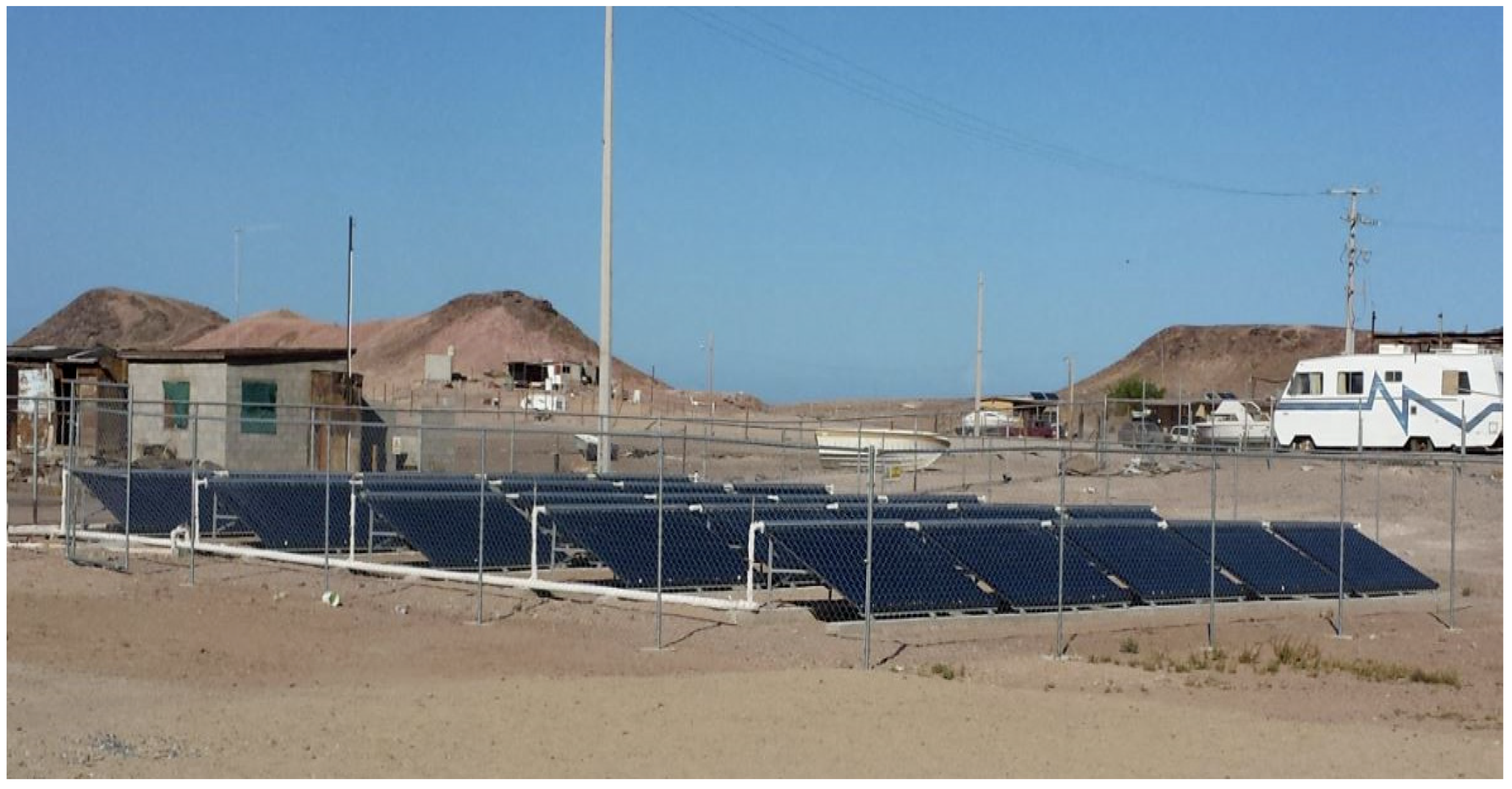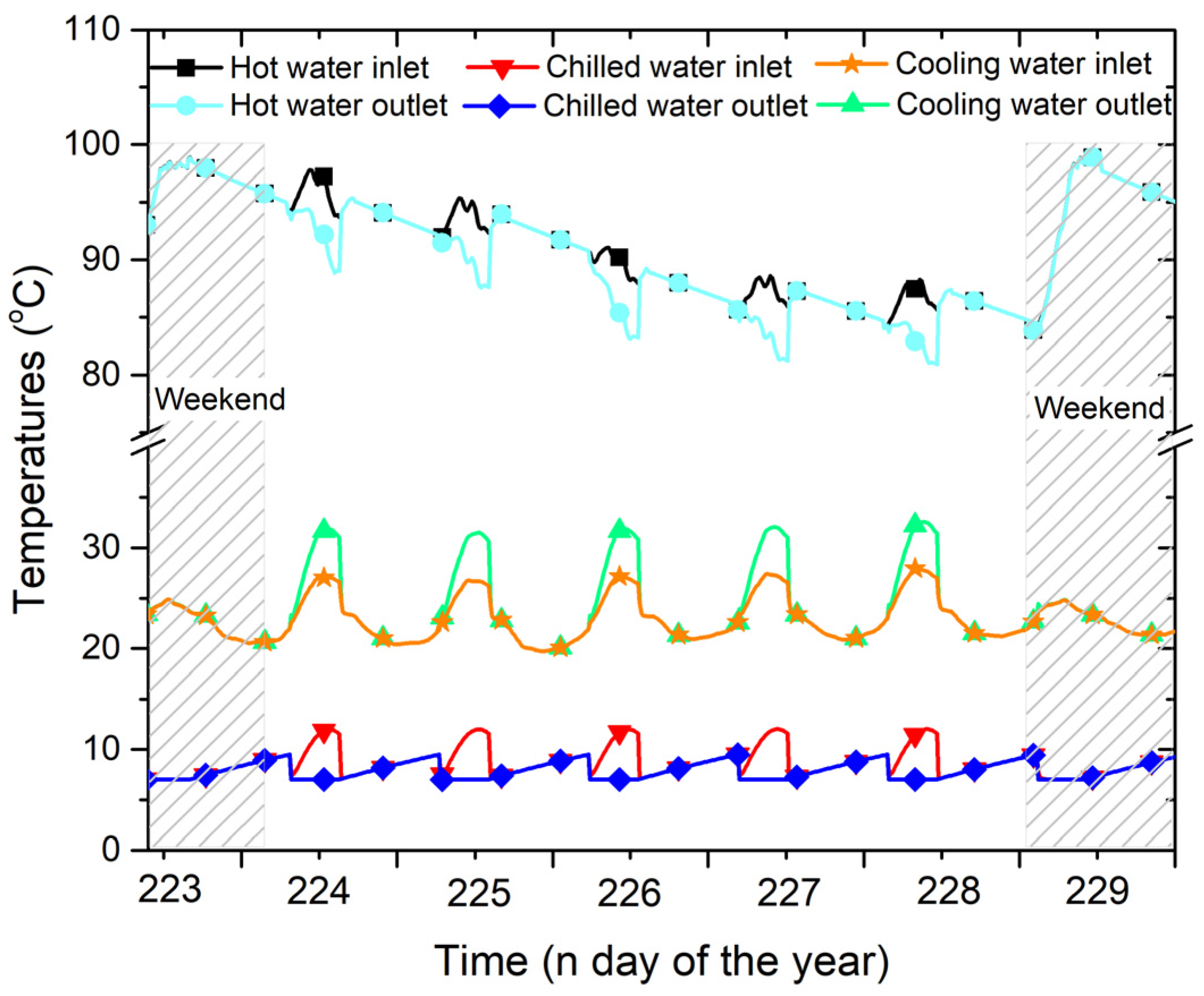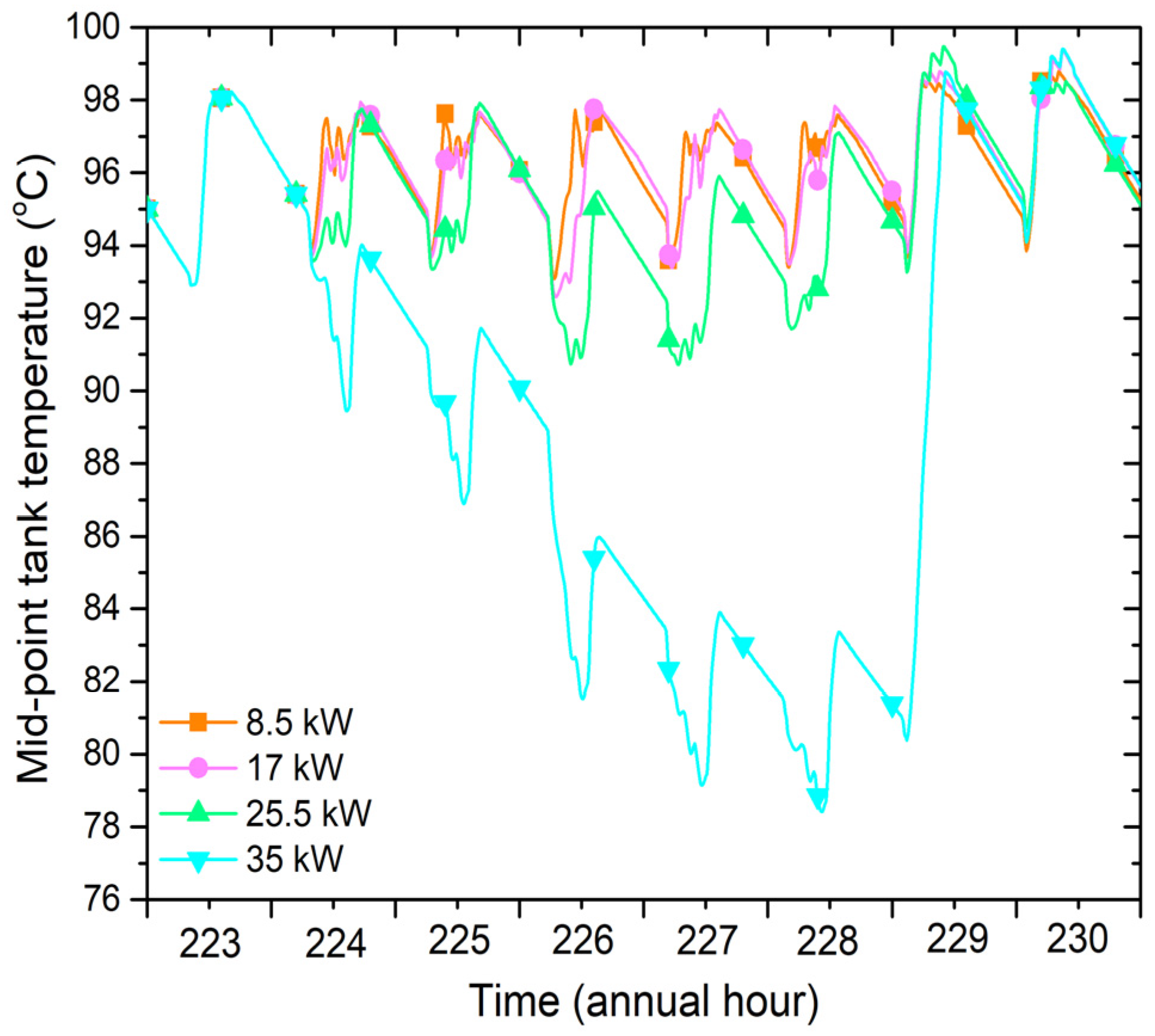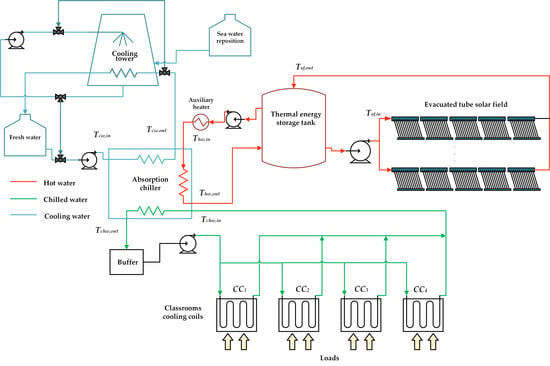Simulation of a Solar-Assisted Air-Conditioning System Applied to a Remote School
Abstract
1. Introduction
2. System Description
3. Methodology
- Steady state;
- 15-min simulation intervals;
- Maximum thermal load of 8.5 kW per classroom at 12:00 p.m.;
- Pressure drops and heat losses in the equipment were not considered, only the heat transferred to the environment by the TEST losses was considered;
- On/off control by temperature difference in the solar field ();
- Only fresh water was used in the cooling water circuit;
- System operation with solar energy only.
4. Results and Discussion
4.1. Operation at Nominal Capacity
4.2. Partial Load Operation
4.3. Evaporation of Cooling Water
5. Conclusions
Author Contributions
Funding
Acknowledgments
Conflicts of Interest
References
- Ehsan, A.; Yang, Q. Scenario-based investment planning of isolated multi-energy microgrids considering electricity, heating and cooling demand. Appl. Energy 2019, 235, 1277–1288. [Google Scholar] [CrossRef]
- Aguilar-Jiménez, J.A.; Velázquez, N.; Acuña, A.; Cota, R.; González, E.; González, L.; López, R.; Islas, S. Techno-economic analysis of a hybrid PV-CSP system with thermal energy storage applied to isolated microgrids. Sol. Energy 2018, 174, 55–65. [Google Scholar] [CrossRef]
- Mittelman, G.; Kribus, A.; Dayan, A. Solar cooling with concentrating photovoltaic/thermal (CPVT) systems. Energy Convers. Manag. 2007, 48, 2481–2490. [Google Scholar] [CrossRef]
- Tsoutsos, T.; Aloumpi, E.; Gkouskos, Z.; Karagiorgas, M. Design of a solar absorption cooling system in a Greek hospital. Energy Build. 2010, 42, 265–272. [Google Scholar] [CrossRef]
- Marc, O.; Lucas, F.; Sinama, F.; Monceyron, E. Experimental investigation of a solar cooling absorption system operating without any backup system under tropical climate. Energy Build. 2010, 42, 774–782. [Google Scholar] [CrossRef]
- Praene, J.P.; Marc, O.; Lucas, F.; Miranville, F. Simulation and experimental investigation of solar absorption cooling system in Reunion Island. Appl. Energy 2011, 88, 831–839. [Google Scholar] [CrossRef]
- Pranesh, V.; Velraj, R.; Christopher, S.; Kumaresan, V. A 50 year review of basic and applied research in compound parabolic concentrating solar thermal collector for domestic and industrial applications. Sol. Energy 2019, 187, 293–340. [Google Scholar] [CrossRef]
- Xu, Z.Y.; Wang, R.Z. Comparison of absorption refrigeration cycles for efficient air-cooled solar cooling. Sol. Energy 2018, 172, 14–23. [Google Scholar] [CrossRef]
- Aguilar-Jiménez, J.A.; Velázquez, N.; Acuña, A.; López-Zavala, R.; González-Uribe, L.A. Effect of orientation of a CPC with concentric tube on efficiency. Appl. Therm. Eng. 2018, 130, 221–229. [Google Scholar] [CrossRef]
- Shirazi, A.; Taylor, R.A.; Morrison, G.L.; White, S.D. Solar-powered absorption chillers: A comprehensive and critical review. Energy Convers. Manag. 2018, 171, 59–81. [Google Scholar] [CrossRef]
- López-Zavala, R.; Velázquez-Limón, N.; González-Uribe, L.A.; Aguilar-Jiménez, J.A.; Alvarez-Mancilla, J.; Acuña, A.; Islas, S. A novel LiBr/H2O absorption cooling and desalination system with three pressure levels. Int. J. Refrig. 2019, 99, 469–478. [Google Scholar] [CrossRef]
- Aliane, A.; Abboudi, S.; Seladji, C.; Guendouz, B. An illustrated review on solar absorption cooling experimental studies. Renew. Sustain. Energy Rev. 2016, 65, 443–458. [Google Scholar] [CrossRef]
- Bataineh, K.; Taamneh, Y. Review and recent improvements of solar sorption cooling systems. Energy Build. 2016, 128, 22–37. [Google Scholar] [CrossRef]
- Lazzarin, R.M.; Noro, M. Past, present, future of solar cooling: Technical and economical considerations. Sol. Energy 2018, 172, 2–13. [Google Scholar] [CrossRef]
- Soto, P.; Rivera, W. Experimental assessment of an air-cooled absorption cooling system. Appl. Therm. Eng. 2019, 155, 147–156. [Google Scholar] [CrossRef]
- Chen, J.F.; Dai, Y.J.; Wang, R.Z. Experimental and analytical study on an air-cooled single effect LiBr-H2O absorption chiller driven by evacuated glass tube solar collector for cooling application in residential buildings. Sol. Energy 2017, 151, 110–118. [Google Scholar] [CrossRef]
- Huang, L.; Zheng, R.; Piontek, U. Installation and Operation of a Solar Cooling and Heating System Incorporated with Air-Source. Energies 2019, 12, 996. [Google Scholar] [CrossRef]
- Rosiek, S. Exergy analysis of a solar-assisted air-conditioning system: Case study in southern Spain. Appl. Therm. Eng. 2019, 148, 806–816. [Google Scholar] [CrossRef]
- Lubis, A.; Jeong, J.; Saito, K.; Giannetti, N.; Yabase, H.; Idrus Alhamid, M. Nasruddin Solar-assisted single-double-effect absorption chiller for use in Asian tropical climates. Renew. Energy 2016, 99, 825–835. [Google Scholar] [CrossRef]
- Sokhansefat, T.; Mohammadi, D.; Kasaeian, A.; Mahmoudi, A.R. Simulation and parametric study of a 5-ton solar absorption cooling system in Tehran. Energy Convers. Manag. 2017, 148, 339–351. [Google Scholar] [CrossRef]
- Li, M.; Xu, C.; Hassanien, R.H.E.; Xu, Y.; Zhuang, B. Experimental investigation on the performance of a solar powered lithium bromide–water absorption cooling system. Int. J. Refrig. 2016, 71, 46–59. [Google Scholar] [CrossRef]
- Calise, F.; Dentice d’Accadia, M.; Palombo, A. Transient analysis and energy optimization of solar heating and cooling systems in various configurations. Sol. Energy 2010, 84, 432–449. [Google Scholar] [CrossRef]
- Cascetta, F.; Di Lorenzo, R.; Nardini, S.; Cirillo, L. A Trnsys Simulation of a Solar-Driven Air Refrigerating System for a Low-Temperature Room of an Agro-Industry site in the Southern part of Italy. Energy Procedia 2017, 126, 329–336. [Google Scholar] [CrossRef]
- Shirazi, A.; Pintaldi, S.; White, S.D.; Morrison, G.L.; Rosengarten, G.; Taylor, R.A. Solar-assisted absorption air-conditioning systems in buildings: Control strategies and operational modes. Appl. Therm. Eng. 2016, 92, 246–260. [Google Scholar] [CrossRef]
- Asim, M.; Dewsbury, J.; Kanan, S. TRNSYS Simulation of a Solar Cooling System for the Hot Climate of Pakistan. Energy Procedia 2016, 91, 702–706. [Google Scholar] [CrossRef]
- Khan, M.S.A.; Badar, A.W.; Talha, T.; Khan, M.W.; Butt, F.S. Configuration based modeling and performance analysis of single effect solar absorption cooling system in TRNSYS. Energy Convers. Manag. 2018, 157, 351–363. [Google Scholar] [CrossRef]
- Xu, Y.Z.; Wang, Z.R. Simulation of solar cooling system based on variable effect LiBr-water absorption chiller. Renew. Energy 2017, 113, 907–914. [Google Scholar] [CrossRef]
- Uçkan, I.; Yousif, A.A. Environmental Effects Simulation of a solar absorption cooling system in Dohuk city of the Northern Iraq. Energy Sources Part A Recover. Util. Environ. Eff. 2019, 0, 1–17. [Google Scholar] [CrossRef]
- Al Dakheel, J.; Aoul, K.T.; Hassan, A. Enhancing green building rating of a school under the hot climate of UAE; Renewable energy application and system integration. Energies 2018, 11, 2465. [Google Scholar] [CrossRef]
- Abrudan, A.C.; Pop, O.G.; Serban, A.; Balan, M.C.; Abrudan, A.C.; Pop, O.G.; Serban, A.; Balan, M.C. New Perspective on Performances and Limits of Solar Fresh Air Cooling in Different Climatic Conditions. Energies 2019, 12, 2113. [Google Scholar] [CrossRef]
- Bellos, E.; Tzivanidis, C. Parametric analysis and optimization of an Organic Rankine Cycle with nanofluid based solar parabolic trough collectors. Renew. Energy 2017, 114, 1376–1393. [Google Scholar] [CrossRef]
- Bellos, E.; Tzivanidis, C. Alternative designs of parabolic trough solar collectors. Prog. Energy Combust. Sci. 2019, 71, 81–117. [Google Scholar] [CrossRef]
- Mendecka, B.; Cozzolino, R.; Leveni, M.; Bella, G. Energetic and exergetic performance evaluation of a solar cooling and heating system assisted with thermal storage. Energy 2019, 176, 816–829. [Google Scholar] [CrossRef]
- Alobaid, M.; Hughes, B.; Kaiser, J.; Connor, D.O.; Heyes, A. A review of solar driven absorption cooling with photovoltaic thermal systems. Renew. Sustain. Energy Rev. 2017, 76, 728–742. [Google Scholar] [CrossRef]
- Li, Z.; Yu, J.; Chen, E.; Jing, Y. Off-Design Modeling and Simulation of Solar Absorption-Subcooled Compression Hybrid Cooling System. Appl. Sci. 2018, 8, 2612. [Google Scholar] [CrossRef]
- Jing, Y.; Li, Z.; Liu, L.; Lu, S. Exergoeconomic assessment of solar absorption and absorption-compression hybrid refrigeration in building cooling. Entropy 2018, 20, 130. [Google Scholar] [CrossRef]
- Klein, S.A.; Beckman, W.A.; Mitchell, J.W.; Duffie, J.A.; Duffie, N.A.; Freeman, T.L.; Mitchell, J.C.; Braun, J.E.; Evans, B.L.; Kummer, J.P.; et al. TRNSYS 17: A Transient System Simulation Program: Mathematical Reference; University of Wisconsin: Madison, WI, USA, 2009. [Google Scholar]









| Solar Collector | |
| Brand/model | Suntask/SHC24 |
| Collector type | Evacuated tube with parabolic reflector |
| Number of tubes | 24 |
| Aperture area | 4.41 m2 |
| Optical efficiency (a0) | 0.668 |
| First order efficiency coefficient (a1) | 1.496 W/m2 K |
| Second order efficiency coefficient (a2) | 0.005 W/m2 K2 |
| Fluid | Water |
| Mass flow | 0.02 kg/sec m2 |
| Number in series | 5 |
| Number of loops | 5 |
| Thermal Energy Storage Tank | |
| Volume | 12 m3 |
| Height | 2.5 m |
| Material | Fiberglass |
| Insulation thickness | 0.025 m |
| Loss coefficient | 1.4 W/m2 K |
| Fluid | Water |
| Absorption Chiller | |
| Model | Lucy New Energy/RXZ-35 |
| Refrigerant | Water–lithium bromide |
| Cooling capacity | 35 kW |
| COP | 0.7 |
| Hot water nominal temperature | 90 °C |
| Hot water nominal flow rate | 8.3 m3/h |
| Chilled water nominal inlet temperature | 15 °C |
| Chilled water nominal flow rate | 6 m3/h |
| Cooling water nominal temperature | 30 °C |
| Cooling water nominal flow rate | 15 m3/h |
| Power consumption | 0.3 kW |
| Component | TRNSYS Type | Description |
|---|---|---|
| Temperature control | 2 | On/off control of feed pumps of the different circuits. |
| Pumps | 3 | Pumps for mass flow feeding of circuits. |
| Time-dependent forcing function | 14 | Cooling system on/off time control. |
| Weather data processor | 15 | Climatological database. |
| Cooling tower | 51 | Evaporative cooling tower with constant volumetric flow. |
| Solar thermal collector | 71 | Evacuated tube solar thermal collector. |
| Absorption chiller | 107 | LiBr/H2O hot water-driven absorption chiller. |
| Thermal energy storage tank | 534 | Stratified thermal storage tank with variable nodes, ports, and insulation. |
| Buffer tank | 534 | Thermal storage tank with variable nodes, ports, and insulation. |
| Mass flow diverter | 647 | Mass flow diverter with variable outlets. |
| Mass flow mixer | 649 | Mass flow mixer with variable inlets. |
| Mass flow heat exchanger | 682 | Energy and mass balance heat exchanger. |
| Heat load | 686 | Heat load profile dependent on the day, weekday, month, or season. |
© 2019 by the authors. Licensee MDPI, Basel, Switzerland. This article is an open access article distributed under the terms and conditions of the Creative Commons Attribution (CC BY) license (http://creativecommons.org/licenses/by/4.0/).
Share and Cite
Aguilar-Jiménez, J.A.; Velázquez, N.; López-Zavala, R.; González-Uribe, L.A.; Beltrán, R.; Hernández-Callejo, L. Simulation of a Solar-Assisted Air-Conditioning System Applied to a Remote School. Appl. Sci. 2019, 9, 3398. https://doi.org/10.3390/app9163398
Aguilar-Jiménez JA, Velázquez N, López-Zavala R, González-Uribe LA, Beltrán R, Hernández-Callejo L. Simulation of a Solar-Assisted Air-Conditioning System Applied to a Remote School. Applied Sciences. 2019; 9(16):3398. https://doi.org/10.3390/app9163398
Chicago/Turabian StyleAguilar-Jiménez, Jesús Armando, Nicolás Velázquez, Ricardo López-Zavala, Luis A. González-Uribe, Ricardo Beltrán, and Luis Hernández-Callejo. 2019. "Simulation of a Solar-Assisted Air-Conditioning System Applied to a Remote School" Applied Sciences 9, no. 16: 3398. https://doi.org/10.3390/app9163398
APA StyleAguilar-Jiménez, J. A., Velázquez, N., López-Zavala, R., González-Uribe, L. A., Beltrán, R., & Hernández-Callejo, L. (2019). Simulation of a Solar-Assisted Air-Conditioning System Applied to a Remote School. Applied Sciences, 9(16), 3398. https://doi.org/10.3390/app9163398










